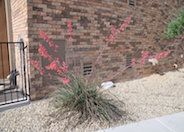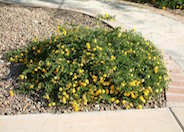
Common name:Bi-colored Hesperaloe
Botanical name:Hesperaloe parviflora 'Duet'
Spectacular accent for desert gardens anywhere. Plants tolerate drought, full sun, reflected heat, and poor soils. Forms rosettes of leaves 4' x 6'. The red and yellow flower stalks emerge in spring and remain on the plant until the end of summer. - Mountain States Nursery

Common name:Lantana
Botanical name:Lantana 'Dwarf Yellow'
This small shrub will reach 3' tall at the most and has small, dark green leaves with yellow flowers that are in constant bloom throughout the year.

Common name:Holly Oak
Botanical name:Quercus ilex
This evergreen oak has a moderate growth rate to 30'-60' tall and as wide. The leaves are 1.5"-3" long, .5"-1" wide, and either toothed or smooth-edged. It has a rich, dark green leaf color.

Common name:American Sycamore or Buttonwood
Botanical name:Platanus occidentalis
This beautiful deciduous tree rapidly reaches 75'-90' tall and 60'-70' wide. It starts out with a pyramidal habit and changes to a broad round crown later. Leaves are simple, green and can be 6"-10" long. Foliage turns yellow brown in fall. Red flowers appear in the spring but are not significant. The bark exfoliatesand can be reddish brown or gray. The peeling bark reveals a white inner bark. This tree needs moist, fertile, well-draining soil with full sun. Plant in large space areas such as parks.

Common name:Silver Maple, Soft or White Maple
Botanical name:Acer saccharinum
This fast-growing, equally spreading tree can reach heights of 40-100'. Leaves of 3"-6" in width are five-lobed, with a light green top color and silvery color beneath. The fall color is a mixture of scarlet, orange and yellow. With an aggressive root system, this tree can be hard on sidewalks and sewers. It is, however, one of the best trees for poor soils where few other trees will grow.
| Designer: Jennifer Barr | Barr Gardens 4 |
Photographer: GardenSoft |
Soils and Compost:
Physical weed control, including mulching, or hand removal protects the watershed from harmful chemicals.
Water Saving Tip:
Remember to check your irrigation system at least once a month, especially your valves, sprinkler heads, and drip emitters.
Integrated Pest Management:
Drip and other smart irrigation delivers water directly to roots, allowing no excess water for weeds.
